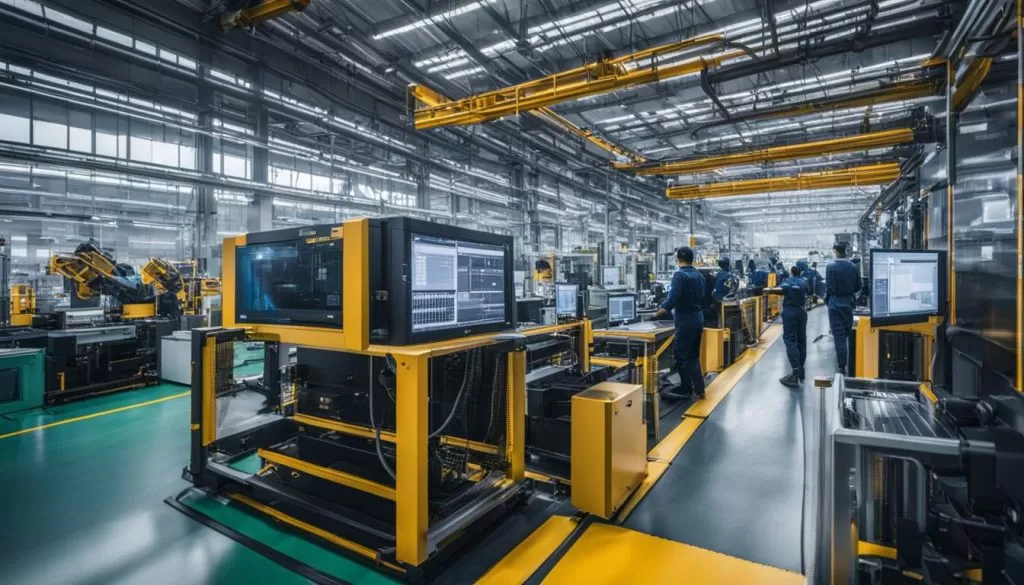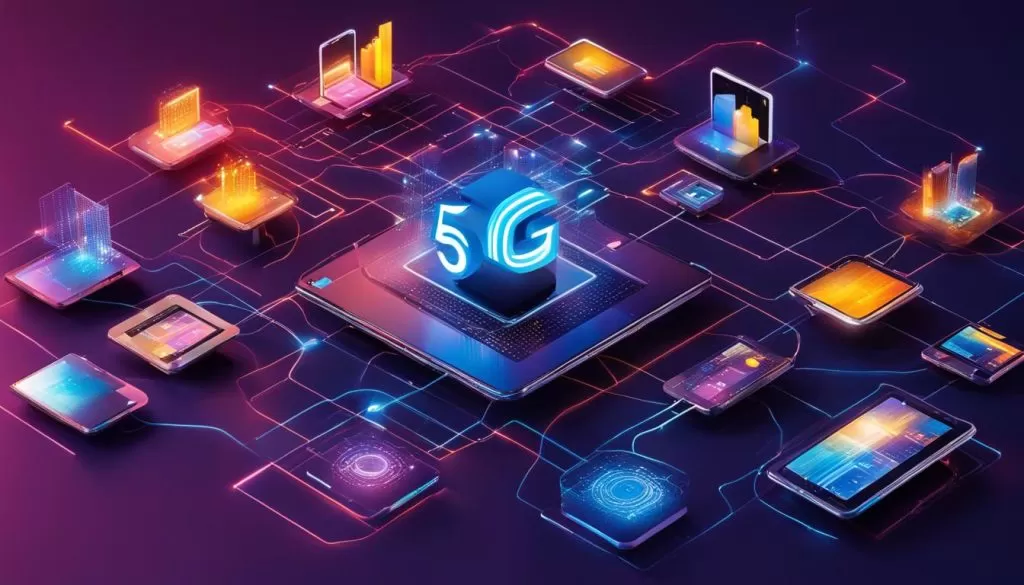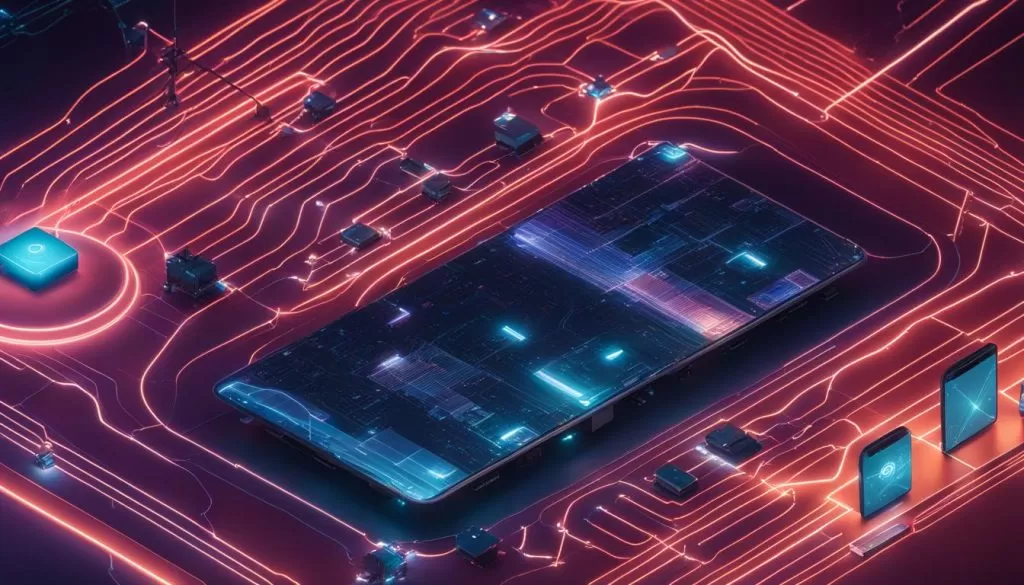Written By:
Scott McAuley
Scott is the IT Director of Texas Management Group, and has been in the IT industry for 25 years.
The 5G impact is ushering in a transformative shift in mobile internet access for businesses and consumers in the United States. This evolution brings about new benchmarks in connectivity and speed through enhanced mobile broadband capabilities and wireless technology advancements.
Moreover, one of the best 5g impacts is the possibilities for virtual reality experiences and revolutionizing cellular networks. In this section, we will delve into the impact of 5G on businesses and consumers in the United States.
5G technology is reshaping the business landscape and transforming the way we view and use mobile devices. With its superfast download speeds and ultra-low latency, 5G is paving the way for the next generation of mobile internet access.
This technology is not just about faster data speeds for wireless communications, it is about creating new opportunities for businesses to do things better and for consumers to experience more.

Key Takeaways:
- 5G technology has enhanced mobile broadband capabilities, setting new standards for connectivity and speed.
- Advancements in wireless technology are revolutionizing cellular networks.
- The 5G impact is unlocking new possibilities for virtual reality experiences.
- 5G is transforming the way businesses and consumers connect and interact, creating new opportunities for innovation.
- With superfast download speeds and ultra-low latency, 5G is paving the way for a new era of mobile internet access.
Table of Contents
Supercharging Business Operations with 5G
The fifth generation (5G) wireless technology is revolutionizing various sectors, and businesses are no exception. With the 5G impact, businesses can take advantage of new opportunities to optimize their operations and streamline their processes.
Augmented reality (AR) is changing manufacturing and retail service models, building smarter cities. Low latency makes possible mission-critical services and cutting-edge innovation. Mobile network operators (MNOs) are also taking advantage of the potential of 5G to help businesses leverage emerging technologies.
The Role of Augmented Reality
One of the most significant 5G impacts is its ability to support AR. AR technologies can now safely and accurately guide workers through complex tasks, reduce training for employees, and offer a new level of customer experience. The manufacturing industry is a perfect example of how businesses are leveraging AR. For instance, workers equipped with AR-enabled glasses can access real-time instructions, cutting time and reducing the risk of errors. Similarly, retailers are using AR to create immersive in-store experiences that customers can control and interact with.
Empowering Smart Cities
5G technology empowers MNOs to transform cities into smart environments. Smart cities use a range of Internet of Things (IoT) devices and sensors that create real-time data. This data can help reduce traffic and congestion, optimize energy consumption, and improve public safety. With 5G’s high-speed connectivity, cities can connect and control these devices without latency or disruption. The result is a better quality of life for people living in urban areas.
Low Latency Capabilities
Low latency is another key attribute of the 5G network, making it a game-changer for mission-critical applications. Latency is the time it takes for a wireless signal to transmit data from source to destination. With low latency, 5G can send and receive data in almost real-time, making it an ideal network for industrial use cases such as robotics and automation, autonomous vehicles, and smart grids.
The Power of MNOs
MNOs are leveraging the potential of 5G technology to help businesses. By enabling businesses to connect with reliable and high-speed networks, MNOs are helping companies improve efficiency and productivity, reduce operating costs, and generate new revenue streams. As 5G technology continues to evolve, MNOs will be integral to the success of businesses all over the world.

Revolutionizing Connectivity for Consumers
Another 5G impact is its ability to revolutionize connectivity for consumers with advancements in mobile broadband and significant increases in download speeds. With the use of mid band spectrum, 5G offers seamless multiplayer cloud gaming experiences for the users.
| 5G vs. 4G Download Speed Comparison | 5G vs. 4G Network Latency Comparison |
|---|---|
| 5G: 100-900 Mbps | 5G: 1-10 ms |
| 4G: 5-12 Mbps | 4G: 20-30 ms |
The increase in download speeds means faster access to critical information, smoother video streaming, and faster downloads. In addition, mid-band spectrum provides a balance between data speed and coverage range, making 5G an ideal solution for gamers and users who consume large amounts of data.
With 5G, multiplayer cloud gaming is more seamless than ever. The low latency network allows for real-time interaction between players, creating a more immersive experience. As a result, game developers are expected to create more interactive multiplayer games for users.

The benefits of 5G for consumers expand beyond gaming. With improved mobile broadband and download speeds, users can enjoy more seamless experiences in mobile video streaming, providing greater convenience and flexibility for individuals on the go.
Empowering Industries with 5G Technology
5G technology is paving the way for unprecedented connectivity solutions and opening up a world of possibilities for businesses and consumers. Through utilization of high band spectrum, wireless telecommunications have been significantly enhanced, shaping the communication landscape for the better. The impact of 5G on mobile phones in particular is remarkable and has widespread implications for the future.
| Benefits of 5G for Industries: | |
|---|---|
| Improved Connectivity Solutions | 5G technology offers ultra-fast and stable connection, improving the reliability and speed of data transfer. This is particularly important for industries that require real-time connectivity, such as the manufacturing, healthcare, logistics, and transportation sectors. |
| High Band Spectrum | 5G networks operate on high band spectrum, which allows for faster speeds and lower latency. This ensures that data-intensive applications, such as video conferencing and multi-device streaming, work smoothly and effectively. |
| Wireless Telecommunications | The deployment of 5G networks will enable wireless telecommunications to be faster and more efficient than ever before. This has major implications in many industries that rely on telecommunications, such as finance, retail, and agriculture. |
| Mobile Phones | 5G technology is set to revolutionize mobile phones by enabling faster and more stable connections, making video streaming, app downloads, and other data-intensive tasks quicker than ever before. This will have a major impact on industries that use mobile phones regularly, such as education, hospitality, and media. |
Looking ahead, businesses and industries that leverage 5G technology are poised for significant growth and innovation. The benefits of the 5G impact is clear, and its impact on connectivity solutions, high band spectrum, wireless telecommunications, and mobile phones are just the beginning.

Enabling Smart Solutions and Innovations
The high-speed capabilities of 5G networks are revolutionizing mobile networks and network infrastructure, enabling seamless connectivity for connected devices. With 5G, you can enjoy faster download and upload speeds, making it easier to watch mobile videos without buffering or lag. The benefits of 5G for mobile video streaming are immense, as ultra-high-definition videos can be viewed on your mobile devices with ease.
5G technology is also supporting the growth of the Internet of Things (IoT) ecosystem, which can help create smart cities. IoT devices require a considerable amount of data for proper functioning, and the high speeds provided by 5G networks can support that data transmission. This connectivity can help create smart solutions for traffic management, public safety, and environmental monitoring projects.
Table: Comparison of 5G and 4G Network Infrastructure
| Network Infrastructure | 4G | 5G |
|---|---|---|
| Latency | 30-50 ms | 1 ms or less |
| Download Speed | 100-300 Mbps | Up to 20 Gbps |
| Upload Speed | Up to 50 Mbps | Up to 1-10 Gbps |
| Spectrum | Low and mid-band (below 6 GHz) | All bands, including low, mid, and high-band (above 6 GHz) |
The 5G network infrastructure is designed to support reliable connectivity solutions, enabling businesses to digitally transform and improve their operations. From optimizing supply chain logistics to creating new revenue streams, 5G technology is catalyzing growth and innovation across various industries.

The 5G impact has made it possible to support innovative services, including autonomous vehicles and virtual reality experiences. This is due to the network-slicing technology that allows the creation of multiple virtual networks within a single physical network. Network slicing enables lower latency, higher speeds, and more reliable connections, making it possible to support mission-critical services such as remote surgery and self-driving cars.
Overall, 5G technology is driving innovation and enabling smarter solutions for connected devices, mobile networks, and network infrastructure. As businesses and consumers continue to adopt 5G, the possibilities for future growth and improved user experiences are limitless.
Fuelling Economic Growth and Sustainability
5G is not only transforming the way we connect, but it also has the potential to fuel economic growth and sustainability. The technology enables critical infrastructure and Internet of Things (IoT) ecosystems that facilitate remote healthcare, improved connectivity, and the delivery of ultra-high-definition video content.
The use of 5G for critical infrastructure serves as a catalyst for economic growth, as it supports industries that rely heavily on real-time data. With 5G, devices can communicate with each other seamlessly, providing unparalleled accuracy and efficiency in data transmission.

Remote healthcare is another sector that is being revolutionized by 5G technology. The enhanced connectivity and improved data speeds provided by 5G enables healthcare providers to remotely monitor and diagnose patients, which can greatly improve access to care for those who would otherwise be underserved. With 5G, medical professionals can transfer large amounts of data, such as medical images, in real-time, enabling faster and more accurate diagnoses.
Improved connectivity is also a significant benefit of 5G technology. With 5G, the number of connected devices can increase exponentially, enhancing the potential for IoT ecosystems. This enables businesses to create applications and services that are more dynamic and responsive, allowing for greater control and customization of products and services.
Ultra-high-definition video content is also a significant beneficiary of 5G technology. With 5G’s high data speeds, users can enjoy immersive, high-quality video content that was previously inaccessible due to bandwidth limitations.
Overall, the impact of 5G on economic growth and sustainability is profound. The technology permits industries that rely on real-time data to operate more efficiently, and it allows healthcare providers to extend their services to remote areas. 5G enables businesses to create new revenue streams, support new industries, and provide better services to their customers.
Unleashing the Potential of New Industries
5G technology is unleashing the potential of new industries, and mobile operators are playing a critical role in driving innovation. With 5G networks, mobile operators can offer new services, such as edge computing, which processes data closer to the source, reducing latency and increasing speed. Additionally, network slicing allows the creation of multiple virtual networks, each tailored to a specific application, ensuring optimal performance for each use case.
The Advantages of Edge Computing
Edge computing is a game-changer for many industries, enabling real-time data processing and analysis, which is critical for applications such as autonomous vehicles and smart cities. With edge computing, data is processed closer to the source, reducing latency and increasing speed. Mobile operators are leveraging edge computing to offer innovative services, such as network slicing and low-latency connectivity, which are essential for mission-critical applications.
The Benefits of Network Slicing
Network slicing is another critical feature of 5G networks that enables the creation of multiple virtual networks, each tailored to a specific application. Network slicing ensures optimal network performance for each specific use case, offering improved reliability, security, and flexibility. Mobile operators can leverage network slicing to support new services, such as IoT applications, which require different network requirements than traditional mobile services.
Compared to previous generations, 5G represents a significant leap forward in terms of network capabilities, offering mobile operators the tools they need to support innovative services and drive economic growth. Whether it’s edge computing, network slicing, or other innovative services, 5G is unleashing the potential of new industries and paving the way for a more connected future.

Revolutionizing User Experiences
As we look towards the future, the capabilities of 5G technology are set to revolutionize user experiences across various industries. With its utilization of radio spectrum, 5G offers high speeds that are set to transform video streaming experiences for consumers.
“The revenue streams generated by the video streaming sector are set to reach $30 billion by 2022, with 5G technology contributing significantly to this growth.”
With the enhanced speeds of 5G, video streaming will be a seamless experience, with virtually no buffering or lag. This will not only improve user experience but also result in significant revenue streams for businesses operating in this sector.
The supply chain will also benefit from 5G technology, with its ultra-fast speeds enabling more efficient and streamlined management of logistics. This is set to reduce waiting times and increase overall efficiency, saving businesses valuable time and money.
5G Technology and Revenue Streams
The revenue streams generated by the video streaming sector are set to reach $30 billion by 2022, with 5G technology contributing significantly to this growth. The enhanced connectivity and high speeds of 5G technology are set to enable seamless video streaming experiences for consumers, resulting in increased demand for content and more significant revenue streams for businesses operating in this sector.
Furthermore, the supply chain will also benefit from 5G technology, with its ultra-fast speeds enabling more efficient and streamlined management of logistics. This is set to reduce waiting times and increase overall efficiency, saving businesses valuable time and money.
As we can see, the impact of 5G on revenue streams and supply chains is significant. By embracing 5G technology, businesses across various sectors can improve their operations, streamline their processes, and generate more revenue in the process.

Driving Innovation with 5G Technology
The benefits of 5G technology are being felt across various industries, especially in the context of smart factories and advanced manufacturing processes. Smart factories utilize the power of 5G to streamline production processes, reduce downtime, and improve efficiency. With 5G network slicing, manufacturers can create dedicated networks for specific use cases, ensuring higher reliability and quality of service.

Moreover, the economic growth brought about by 5G technology is poised to be significant. According to a study by Qualcomm, by 2035, 5G will enable $12.3 trillion worth of goods and services, contributing 5.2% to global GDP. This will be driven by increased productivity and efficiency across industries, which will lead to job creation and economic growth.
5G technology also has the potential to reduce carbon emissions and promote sustainability. With ultra-low latency and high-speed connectivity, remote monitoring and control of energy consumption in smart factories and other industries is possible. In turn, this will enable more efficient and optimized use of resources, reducing waste and carbon emissions.
In conclusion, 5G technology is set to drive innovation, economic growth, and sustainability, particularly in the context of smart factories and advanced manufacturing processes. Network slicing and reduced latency will enable reliable and high-quality connectivity while contributing to a more efficient and sustainable future.
Unlocking the Future Potential
As we look to the future potential of 5G technology, it’s important to understand the advancements that it brings compared to previous generations. With ultra-low latency and the use of the 0/1-2 millimeter wave spectrum, 5G has the capability to revolutionize connectivity in ways never before seen.
One of the most exciting possibilities for 5G is in low-earth orbit satellite communications. With the ability to transmit data quickly and efficiently, 5G networks can provide a significant improvement in communication between satellites and Earth-based devices. This opens up new opportunities for space exploration and research.

Additionally, the ultra-low latency of 5G has the potential to enable new applications that were previously impossible due to latency constraints. For example, 5G could potentially enable remote surgeries and other critical services that require real-time communication.
The use of the 0/1-2 millimeter wave spectrum in 5G also offers the potential for extremely high speeds, even compared to the already impressive speeds of 5G. This could pave the way for new revenue streams and business opportunities, particularly in industries that rely on high-speed data transfer.
All these advancements in 5G technology make it clear that the potential for innovation and improved user experiences is limitless. As we continue to unlock the full potential of 5G, we can expect to see even more advancements in the coming years.
Conclusion
In conclusion, 5G technology is transforming the way businesses operate and consumers connect. With its enhanced mobile broadband capabilities, low latency, and high-speed connectivity, 5G is revolutionizing the way industries operate, empowering them with advanced communication technologies and innovative solutions.
Not only is 5G enhancing connectivity and providing seamless mobile internet access, but it is also driving economic growth and sustainability. With the support of critical infrastructure and the Internet of Things (IoT) ecosystem, 5G is enabling remote healthcare and delivering ultra-high-definition video content.
The potential of 5G technology is limitless, and it is unlocking new opportunities for industries to thrive. From smart factories to innovative services enabled by mobile operators, 5G is driving innovation and supporting economic growth. The technology is also contributing to a better future, with its potential to reduce carbon emissions and create sustainable solutions.
Ready to Leverage 5G for Better Connectivity?
Dive into our blogs to understand the full impact of 5G on business, and discover how our Network Management and Monitoring Services can help you stay connected with speed and stability.
Future-proof your network now!
FAQ
What is the Impact of 5G Technology on Businesses and Consumers?
5G technology has a significant impact on businesses and consumers in the United States. It enhances mobile broadband capabilities, advances wireless technology, and provides benefits for virtual reality experiences and mobile internet access. Additionally, 5G revolutionizes connectivity for cellular networks, bringing about a new era of connectivity for both businesses and consumers.
How Does 5G Supercharge Business Operations?
5G supercharges business operations by enabling augmented reality in industries such as manufacturing and retail. It empowers smart cities through collaborations with mobile network operators. Additionally, 5G’s low latency capabilities are crucial for supporting mission-critical services and improving operational efficiency in various sectors.
How Does 5G Revolutionize Connectivity for Consumers?
5G revolutionizes connectivity for consumers by significantly enhancing mobile broadband and download speeds. With the use of mid-band spectrum, seamless multiplayer cloud gaming experiences have become a reality. Consumers can enjoy faster and more reliable internet connections, improving their overall digital experiences.
How Does 5G Empower Industries?
5G empowers industries by providing advanced connectivity solutions. It utilizes a high band spectrum to enhance wireless telecommunications, benefiting various sectors. Moreover, 5G has a profound impact on mobile phones, driving innovation in communication technologies and improving connectivity for industries.






